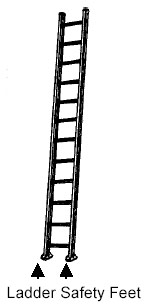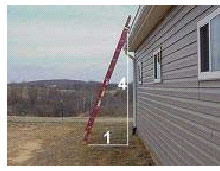
Investigation: # 01MI047
Corrections Officer Dies When He Falls Off Ladder While Supervising Prison Work Crew
SUMMARY
 |
| Police Department Photograph |
RECOMMENDATIONS
INTRODUCTION
On July 8, 2001, a 40-year old male correction officer died from injuries sustained when he fell off an 18-foot wood straight ladder on January 24, 2001. On July 10, 2001, MIFACE investigators were notified of the work-related construction fatality by the Michigan Occupational Safety and Health Administration (MIOSHA) 24-hour fatality report system that a work-related death occurred on July 8, 2001. The correctional facility agreed to participate in the MIFACE program, and on December 5, 2001 a MIFACE researcher interviewed the deputy warden of the facility. The death certificate, autopsy results, police report (including photographs of the ladder and building), a Michigan Department of Corrections Public Works Agreement, and the MIOSHA narrative were obtained during the course of the investigation.
The MIOSHA investigation resulted in one citation to the employer; safety feet were not on the wood ladder.
INVESTIGATION
Department of Correction camps are under the jurisdiction of a parent prison near them. The camp warden reports all camp operational aspects, including health and safety issues to the parent prison. The parent prison in turn, provides health and safety support to the camp. All correction officers receive health and safety training from MIOSHA Consultation Education & Training (CET). Additional training, such as chainsaw training, is provided from an outside contractor.
At this camp, there is a correction officer responsible for overseeing all work crews. This officer may go out with the work crew at the jobsite to orient the crew to the site’s potential safety and health hazards. This officer, sometimes with the camp warden, also conducts unannounced inspections of work sites to ensure all safety and health rules, as well as security measures, are in place and that work practice rules followed. When the unannounced worksite inspection uncovers violations of procedure (work practice, health and safety or security), measures are initiated immediately to correct the violation.
Anytime a work crew performs new work for an existing project agency or a new project agency enters into a Department of Corrections Public Works Agreement, the correction officer directly supervising the work crew (crew supervisor) reviews the job site. Crew supervisors also receive training to survey the work site for potential security and health and safety concerns. Correction officers receive at least 8 hours of safety and health training per year. Most crew supervisors have many years of experience in work crew supervision and, according to the deputy warden, are well versed on different pieces of equipment used by the prisoners. The crew supervisor is responsible for ensuring that the prisoner is properly trained in the use of the tools he/she will work with and must ensure prisoners are following safe work procedures.
Work on the job site is not initiated until the crew supervisor is satisfied that the job can be performed in a secure fashion (i.e., prisoner escape and performed in a safe manner.) If a correction officer has a health and safety concern about the equipment provided by the project agency, he/she is directed by the camp health and safety police to contact the camp health and safety officer for assistance in determining if the equipment is safe to use.
The camp had written procedures for taking work crews on-site. The camp had specific work practice rules for certain situations, such as cutting trees near power lines. There were no specific work practice rules to follow in the snow- clearing operations. Neither the prisoners nor correction officer were required to wear any personal protective equipment, such as a hard hat when standing on the ground. Prisoners were not required to wear any fall protection while on the roof.
The camp had a written health and safety program. Monthly health and safety meetings are held with the management of the correctional facility and representatives of the unions present at the facility. Monthly reports are generated and distributed to union representatives. All employees are encouraged to review the monthly health and safety meeting minutes.
A correction camp can enter into a public works agreement with other governmental agencies and/or non-profit agencies to perform work Department of Correction Public Works Agreement. This contract requires the project agency to provide all equipment necessary to perform the job. Under the contract, the camp has the flexibility to determine how to safely perform the work prescribed in the contract. The camp also has the flexibility to tell the project agency what equipment is needed to perform the work.
The deputy warden stated that when a correctional facility enters into a contract with other agencies to have a prison work crew perform work, this contract does not have a requirement for equipment supplied by the project agency to meet MIOSHA rules and/or industry safety standards. It is the responsibility of the work crew supervisor to determine if a piece of equipment is "safe" to use. When there is a question about equipment meeting health and/or safety requirements, the correction officer must contact the correctional officer in charge of all work crews for guidance. The victim had not received training on the requirements of MIOSHA General Industry Safety Standard, Part 4, Portable Ladders.
The victim had been with the department of corrections as a full time employee for at least ten years and had taken work crews out for that period of time. The correction officer had been to this site many times over the past ten years. The victim was considered a "hands-on" type of worker and had a good relationship with the work crew, supervising this crew on other work sites.
 |
The snow clearing operation began with one inmate climbing the ladder to the roof. The correction officer was supposed to stay on the ground during the snow clearing operation. The inmate on the roof called out to the correction officer. It is unknown what the inmate said that caused the correction officer to climb the ladder. The other inmate held the ladder to steady it as the victim climbed up to the roof. The victim was wearing appropriate winter clothing and work boots. It is unknown if the victim knocked the snow off of his boots prior to ascending the ladder. Snow on the boot soles could affect traction on the ladder rungs. The officer was not carrying any piece of equipment to the roof surface.
The sequence of events leading to the fall from the ladder is unknown. One possible scenario is that as the victim began to transfer his weight from the ladder to the roof, the ladder slipped and the victim’s foot became entangled, he lost his balance and fell backward toward the asphalt with his foot still entangled in the ladder. Another possible scenario is as the victim neared the roofline, the victim’s foot became entangled between the ladder rungs causing the ladder to slip on the icy surface. The inmate holding the ladder stated that the victim’s foot was entangled in the ladder when he struck the ground. The inmate holding the ladder contacted the property owners, and emergency response was requested. The emergency responders stabilized the victim and transported him to a local hospital. He was released from the hospital and returned home with outpatient treatment. He began having seizures at home, was re-hospitalized, and later died.
After the accident, the camp instituted a work practice that snow rakes are to be used by prisoners standing on the ground when removing snow from building roofs. Ladder safety training for correctional officers was presented by MIOSHA after this incident.
CAUSE OF DEATH
The medical examiner recorded the cause of death as status epilepticus due to a closed head injury due to a fall from a ladder six months previously. There was no autopsy performed in this incident. There was no suggestion during the investigation that illegal drug use or alcohol use played a role in the death.
RECOMMENDATIONS/DISCUSSION
• The Michigan Department of Corrections Public Works Agreement should specify the work tools and materials supplied by the project agency meet all MIOSHA safety and health standards.
The Michigan Department of Corrections Public Works Agreement states that work shall comply with all applicable required state and federal safety standards. The Work Agreement also states that the project agency supply the work tools and materials for use by the prison work crew. The Agreement does not require that the project agency to supply work tools and materials that comply with MIOSHA health and safety standards. The 18-foot wood straight ladder supplied by the project agency did not have safety feet. The Department of Corrections Public Works Agreement should be modified to require project agencies to supply tools and materials that meet MIOSHA health and safety standards.
• Correctional facilities should train all correctional officers acting as crew supervisors to conduct a job hazard analysis prior to performing work that includes hazard recognition and avoidance, safe work procedure training, and enforce the existing policy of reporting unsafe equipment to the prison camp.
The employer had a written safety program, but had not completed necessary MIOSHA health and safety training, including hazard recognition training, for all correctional officers in charge of work crews. The correction officer supervising the work crews is responsible for maintaining security at the work site and health and safety concerns; correction officers should not perform the job tasks assigned to the prisoners.
The correctional officer had not received ladder safety training. Ladder safety training would include information about ladder inspection and the requirement for a ladder to have safety feet. Training should also include safety measures a person should take prior to ascending the ladder, i.e. making sure boots are free from grease, oil and contaminants to minimize slipping on the rungs. It is unknown if the ladder was appropriately labeled and if victim knew that safety feet were required on the ladder. It is also unknown if the victim asked the project agency for another ladder. Following the incident, MIOSHA provided a ladder safety class to work crew supervisors.
A job hazard analysis is a procedure used to review each job, identify potential hazards, and design actions and procedures to eliminate or control the hazards. Input from workers who usually perform the tasks is important. Of primary importance is the recognition that hazards exist. Camp work policies and training should be implemented based upon the findings of the job hazard analysis.
The camp did not have a written procedure in place for a safe method of snow removal from a roof height. The camp should conduct a job hazard analysis for existing contractual work and the camp’s health and safety program should be revised to require a job hazard analysis be conducted for new work contracts, and for providing employee job hazard analysis training. Especially in a prison camp, which accepts work contracts from many different clients, job hazard analysis training should be conducted so crew supervisors can recognize unsafe work practices and potentially hazardous work conditions when setting up the job. The camp safety officer (or MIOSHA consultant) can provide hazard analysis training as part of the development and implementation of the camp’s health and safety program.
 |
The ladder was also used on an icy surface; the area was shoveled, but not de-iced. The icy surface may have been a factor in this fatal incident. By not de-icing the surface, the ladder base was unstable. A ladder should not be directly placed on a slippery surface; a non-slip mat or other surface should be provided. A ladder should have non-skid feet or spurs to prevent slipping.
It is also unknown if the straight ladder was correctly set using the "4 to 1 rule"; set the ladder’s base 1 foot from the wall for each 4 feet of ladder length. Rungs are generally one foot apart, so an estimate of the distance of the base from the wall can be done on-site.
• Camp management should emphasize the importance of reporting unsafe equipment to the prison camp safety officer.
The victim did not report the faulty ladder to the camp as required by the camp’s health and safety policy. The camp should emphasize the importance of reporting unsafe equipment to the camp not using the equipment.
• The parent prison facility should develop safe use procedures, including a health and safety checklist for equipment commonly used by work crews on public work projects, such as chain saws, chippers, ladders and forklifts.
Although only a ladder was used in this incident, the camp deputy warden stated that many public works projects require the use of chainsaws, ladders, chippers, etc. by the work crew. An audit to identify the equipment used by the work crews would be the first step in the development of a checklist for each piece of equipment.. Checklists provide a standardized method to ensure that equipment provided by the project agency meets MIOSHA requirements, is properly labeled, is maintained and is safe for use.
MIOSHA General Industry Safety Standards, Part 4, Portable Ladders establishes the minimum requirements for the construction, care and use of portable ladders. Part 4, Rule 445 describes general ladder safe use procedures and Rule 447 describes safe use procedures for straight, sectional and extension ladders. Rule 447 states that straight ladders must have a secure footing and safety feet. The ladder shall be placed so it cannot slip or it shall be lashed or held in position. The icy surface was not a secure footing and the lack of safety feet made it even less secure. The ladder was not lashed to the building; an inmate held the ladder while standing on the ground and he was unable to adequately stabilize the ladder.
Part 4, Rule 443 requires that ladders must be inspected before its use as well as after it has fallen or been involved in an accident to determine if it needs repair or replacement.
Rule 443 specifies the ladder conditions that require a ladder to be repaired or replaced. Ladder inspection should include at least: condition of rung, cleats, steps, side rails and safety feet (no cracks, bends, breaks, free of oil and grease, etc.), hardware and fittings secure and undamaged, and moveable parts operate freely. There are many examples of ladder checklists (and safe ladder procedures) on the Internet that can be tailored for site-specific use. Ladder safe use procedures should be developed and implemented. As part of the procedure, prior to ladder use, the ladder checklist should be completed to ensure the ladder is properly maintained and safe for use.
• Correctional facility employees must be trained in the procedures to safely perform a personnel lift using approved platforms.
MIOSHA General Industry Safety Standard, Part 21, Powered Industrial Trucks provides minimum safety rules for the care and use of powered industrial trucks and provides for operator safety and equipment specifications. Part 21, Rule 2167 (1) states that an employee shall not be lifted or transported except when a platform is attached to the forks by enclosed sleeves, a safety chain or a mechanical device in such a manner that the platform cannot tip or slip. The deputy warden indicated that inmates are elevated with a hi-lo while standing on a wood pallet. A wood pallet does not meet the specific requirements listed in Rule 2167 (1-4). The camp should prohibit the lifting of inmate using wood pallets or any other unapproved lifting device.
RESOURCES
All MIOSHA Standards cited in this report can be found at the Consumer and Industry Services, Bureau of Safety and Regulation Standards Division website at www.michigan.gov/cis. Follow the links Worker Safety & Health then Standards & Legislation to locate and download MIOSHA Standards. The Standards can also be obtained for a fee by writing to the following address: Department of Consumer and Industry Services, MIOSHA Standards Division, P.O. Box 30643, Lansing, MI 48909-8143. MIOSHA phone number is (517) 322-1845.
MIFACE (Michigan Fatality and Control Evaluation), Michigan State University (MSU) Occupational & Environmental Medicine, 117 West Fee Hall, East Lansing, Michigan 48824-1315. This information is for educational purposes only. This MIFACE report becomes public property upon publication and may be printed verbatim with credit to MSU. Reprinting cannot be used to endorse or advertise a commercial product or company. All rights reserved. MSU is an affirmative-action, equal opportunity employer.
To contact Michigan State FACE program personnel regarding State-based FACE reports, please use information listed on the Contact Sheet on the NIOSH FACE web site Please contact In-house FACE program personnel regarding In-house FACE reports and to gain assistance when State-FACE program personnel cannot be reached.